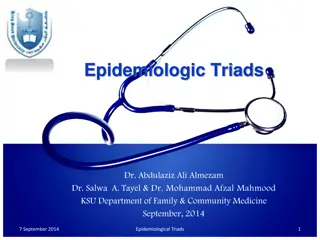Measles and Rubella Global Update December 2023
Stay informed with the latest data on measles and rubella cases worldwide with this report. Surveillance data, epidemiologic data, and laboratory reports are analyzed and updated monthly. For accurate and up-to-date information on the global status of measles and rubella, access this report. To rece
8 views • 63 slides
Global Measles and Rubella Update - April 2024
The Global Measles and Rubella Report provides provisional data on the reported cases of measles and rubella, distributed monthly via email. Official numbers are available in July each year through the WHO/UNICEF annual data collection. The report is based on surveillance data from Member States, wi
7 views • 62 slides
Understanding Epidemiologic Triads in Disease Causation
Epidemiologic triads are essential models for studying disease causation, with a focus on descriptive and analytical epidemiology. By exploring factors such as person, place, time, agent, host, and environment, researchers can identify key relationships in the spread and prevention of diseases. The
2 views • 24 slides
Integration Approaches of Propensity Scores in Epidemiologic Research
Propensity scores play a crucial role in epidemiologic research by helping address confounding variables. They can be integrated into analysis in various ways, such as through regression adjustment, stratification, matching, and inverse probability of treatment weights. Each integration approach has
0 views • 20 slides
Classification of Elements and Periodicity in Properties: Overview and Evolution
The journey of understanding the classification of elements and periodicity in properties begins with early laws like the Law of Triads and Newland's Law of Octaves. Mendeleev's Periodic Law revolutionized the organization of elements, leading to the modern periodic table. Discoveries of eka-alumini
3 views • 32 slides
Evolution of Periodic Table and Classification of Elements
The Periodic Table is a systematic arrangement of elements based on atomic number and properties. Over time, chemists developed various classification methods such as Dobereiner's Triads, Newland's Law of Octaves, Mendeleev's Periodic Table, and the Modern Periodic Table to organize the increasing n
1 views • 26 slides
Epi-Ready: Investigating Foodborne Outbreaks & Epidemiologic Approaches
In Module 6 of the Epi-Ready Epidemiologic Investigation series, participants learn about epidemiologic approaches in responding to foodborne outbreaks. The module covers methods for information gathering, measures of association, statistical significance, case definitions, surveillance activities,
1 views • 41 slides
Foodborne Illness Outbreak Investigation Procedures and Protocols
In this self-paced exercise developed by the New York State Integrated Food Safety Center of Excellence, learners will delve into the intricacies of investigating foodborne illness outbreaks. The course covers topics such as identifying outbreak patterns, roles in outbreak investigations, interpreti
0 views • 171 slides
Evolution of Periodic Table: From Dobereiner's Triads to Modern Classification
Explore the historical journey of the Periodic Table, starting from the early attempts by Al-Razi and Lavoisier to the concept of Dobereiner's Triads, which paved the way for modern element classification based on properties and atomic masses.
0 views • 43 slides
Overview of Necrotizing Pneumonia in Children
Necrotizing pneumonia in children is characterized by necrosis of pulmonary tissue, leading to the formation of small cavities containing necrotic debris or fluid. Staphylococcus Aureus and Streptococcus Pneumoniae are common pathogens. Treatment involves a prolonged course of IV antibiotics tailore
0 views • 34 slides
The Harmonious Connection Between Mathematics and Music
Explore the fascinating relationship between mathematics and music through concepts like triads, chord progressions, and operations on triads defined by music theorist Hugo Riemann. Delve into the mathematical descriptions of chord progressions, major and minor chords, and chord transformations, unv
0 views • 36 slides
Understanding Chord Structures in Music Theory
Explore the principles of diatonic chords, including major, minor, dominant, diminished, and augmented chords. Learn about major chords like triads, 6/9, 6th, 7th, 9th, 13th, and 7#11, followed by minor chords such as triads, 6th, 6/9, 7th, 9th, 11th, and 7b5*half diminished. Dive into dominant chor
0 views • 39 slides
Evolution of the Periodic Table: From Dobereiner to Mendeleev
The evolution of the periodic table, from Dobereiner's Law of Triads to Newlands' Law of Octave, and finally Mendeleev's Periodic Law and Original Periodic Table, marked significant strides in organizing chemical elements based on their properties and atomic weights. Each contribution led to the ref
0 views • 14 slides
Exploration of Endpoints in Clinical Trials for Alcohol Use Disorder
This presentation discusses the exploration of endpoints in pivotal clinical trials to treat Alcohol Use Disorder (AUD), focusing on Primary Alcohol Drinking Endpoints like PSNHDD. Evidence supporting PSNHDD as a primary endpoint includes clinical benefit data from alcohol clinical trials and epidem
0 views • 54 slides
Understanding Disease Development and Prevention
Explore the theories of disease development, the concept of the iceberg phenomenon, and the significance of prevention, control, elimination, and eradication in managing diseases. Learn about historical and modern theories, including the germ theory, epidemiologic triad, and the web causation model.
0 views • 21 slides
Comments on Draft Risk Evaluation for Asbestos by Gabor Mezei, M.D., Ph.D.
Gabor Mezei, M.D., Ph.D., a Principal Scientist at Exponent, Inc., provides insightful comments on the Draft Risk Evaluation (DRE) for asbestos. He highlights the occurrence of mesothelioma in the absence of asbestos and challenges the assumption of increased risk in users of AABL. Mezei references
0 views • 8 slides
Understanding Infectious Diseases and Prevention Strategies
Infectious diseases are caused by pathogens like bacteria, viruses, parasites, or fungi invading the body. These diseases can spread from person to person and sometimes from animals to humans. Common characteristics include potential severe outcomes, transmission modes, and the role of pathogens. Th
0 views • 27 slides
Understanding Veteran Homelessness: Statistics and Health Risks
Explore the epidemiologic characteristics, health concerns, and outcomes of homeless veterans, along with national and state-specific numbers. Discover the challenges faced by homeless veterans and the efforts being made to combat veteran homelessness.
0 views • 29 slides
China's Health Transitions: Diseases of Poverty and Affluence
China's health transitions encompass changes in medicine and population health, influenced by factors like demographic shifts, disease patterns, and societal determinants. Challenges with data accuracy and the country's 20th-century demographic evolution are highlighted, including issues related to
0 views • 15 slides


















